Measuring a Country’s Macroeconomy: Principles, Theories, Policies
VerifiedAdded on 2023/06/08
|14
|4065
|458
Essay
AI Summary
This essay provides a comprehensive analysis of how economists measure a country's macroeconomy, focusing on key components such as GDP, inflation, unemployment, and balance of payments. It identifies a range of economic problems facing modern societies, including unemployment, inflation, and unfavorable balance of payments, and discusses the impact of micro and macroeconomic principles. The essay explores elementary economic theories like monetarism and Keynesian economics, evaluating conflicting claims about the economy and assessing the impact of government economic policies on the domestic economy. It emphasizes the importance of both micro and macroeconomic principles in fostering economic growth and highlights how elementary economic theories can be applied to solve economic problems, concluding with an evaluation of conflicting claims and the effects of government policies.
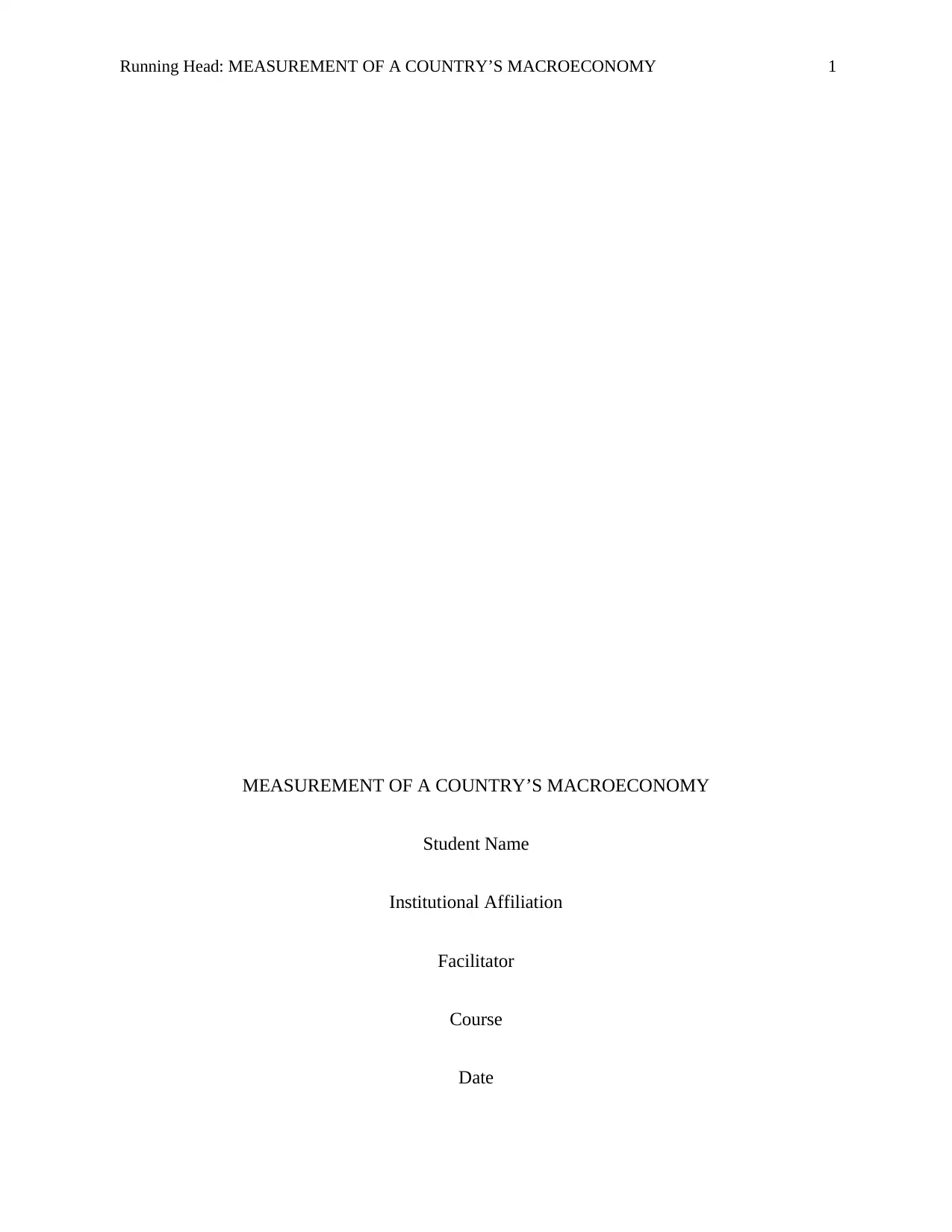
Running Head: MEASUREMENT OF A COUNTRY’S MACROECONOMY 1
MEASUREMENT OF A COUNTRY’S MACROECONOMY
Student Name
Institutional Affiliation
Facilitator
Course
Date
MEASUREMENT OF A COUNTRY’S MACROECONOMY
Student Name
Institutional Affiliation
Facilitator
Course
Date
Paraphrase This Document
Need a fresh take? Get an instant paraphrase of this document with our AI Paraphraser
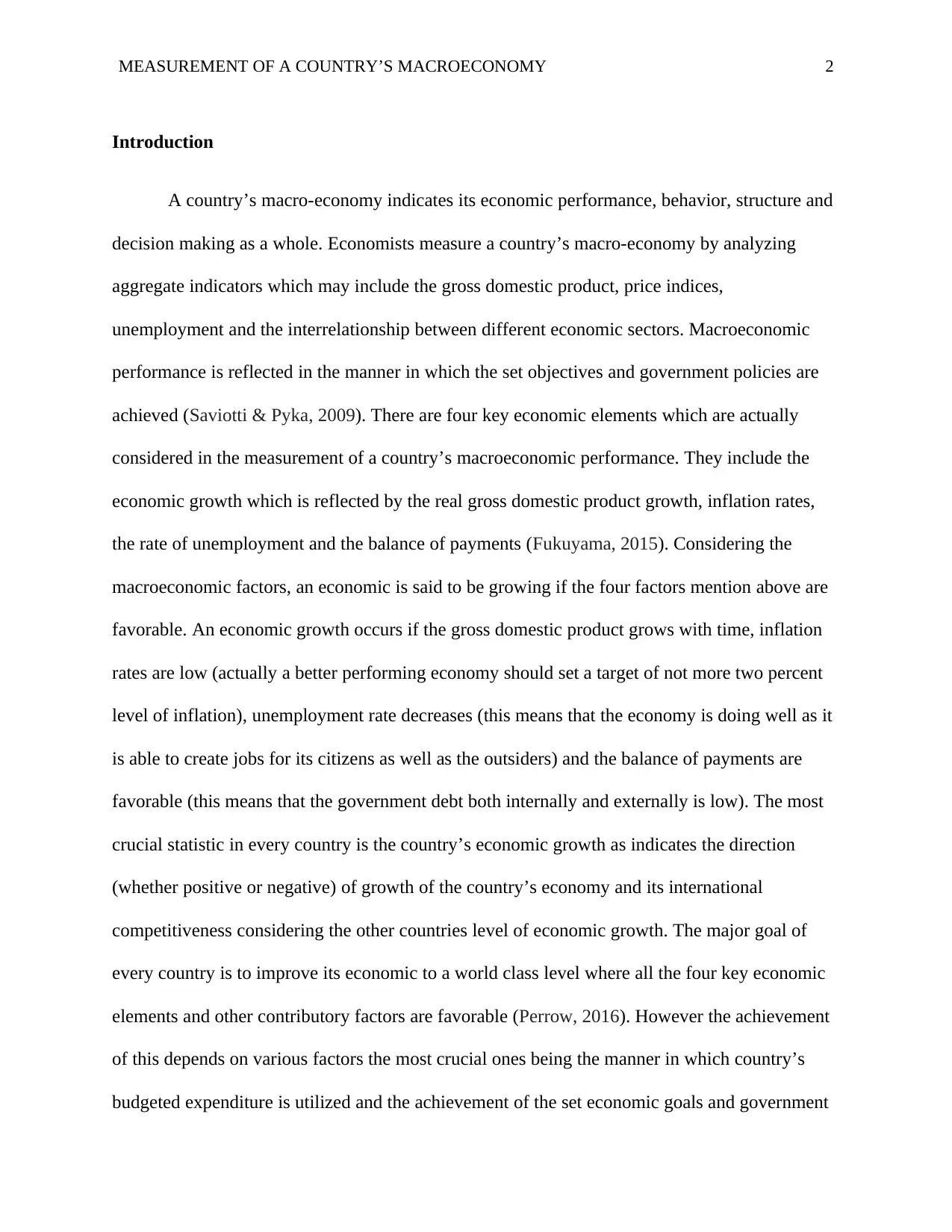
MEASUREMENT OF A COUNTRY’S MACROECONOMY 2
Introduction
A country’s macro-economy indicates its economic performance, behavior, structure and
decision making as a whole. Economists measure a country’s macro-economy by analyzing
aggregate indicators which may include the gross domestic product, price indices,
unemployment and the interrelationship between different economic sectors. Macroeconomic
performance is reflected in the manner in which the set objectives and government policies are
achieved (Saviotti & Pyka, 2009). There are four key economic elements which are actually
considered in the measurement of a country’s macroeconomic performance. They include the
economic growth which is reflected by the real gross domestic product growth, inflation rates,
the rate of unemployment and the balance of payments (Fukuyama, 2015). Considering the
macroeconomic factors, an economic is said to be growing if the four factors mention above are
favorable. An economic growth occurs if the gross domestic product grows with time, inflation
rates are low (actually a better performing economy should set a target of not more two percent
level of inflation), unemployment rate decreases (this means that the economy is doing well as it
is able to create jobs for its citizens as well as the outsiders) and the balance of payments are
favorable (this means that the government debt both internally and externally is low). The most
crucial statistic in every country is the country’s economic growth as indicates the direction
(whether positive or negative) of growth of the country’s economy and its international
competitiveness considering the other countries level of economic growth. The major goal of
every country is to improve its economic to a world class level where all the four key economic
elements and other contributory factors are favorable (Perrow, 2016). However the achievement
of this depends on various factors the most crucial ones being the manner in which country’s
budgeted expenditure is utilized and the achievement of the set economic goals and government
Introduction
A country’s macro-economy indicates its economic performance, behavior, structure and
decision making as a whole. Economists measure a country’s macro-economy by analyzing
aggregate indicators which may include the gross domestic product, price indices,
unemployment and the interrelationship between different economic sectors. Macroeconomic
performance is reflected in the manner in which the set objectives and government policies are
achieved (Saviotti & Pyka, 2009). There are four key economic elements which are actually
considered in the measurement of a country’s macroeconomic performance. They include the
economic growth which is reflected by the real gross domestic product growth, inflation rates,
the rate of unemployment and the balance of payments (Fukuyama, 2015). Considering the
macroeconomic factors, an economic is said to be growing if the four factors mention above are
favorable. An economic growth occurs if the gross domestic product grows with time, inflation
rates are low (actually a better performing economy should set a target of not more two percent
level of inflation), unemployment rate decreases (this means that the economy is doing well as it
is able to create jobs for its citizens as well as the outsiders) and the balance of payments are
favorable (this means that the government debt both internally and externally is low). The most
crucial statistic in every country is the country’s economic growth as indicates the direction
(whether positive or negative) of growth of the country’s economy and its international
competitiveness considering the other countries level of economic growth. The major goal of
every country is to improve its economic to a world class level where all the four key economic
elements and other contributory factors are favorable (Perrow, 2016). However the achievement
of this depends on various factors the most crucial ones being the manner in which country’s
budgeted expenditure is utilized and the achievement of the set economic goals and government
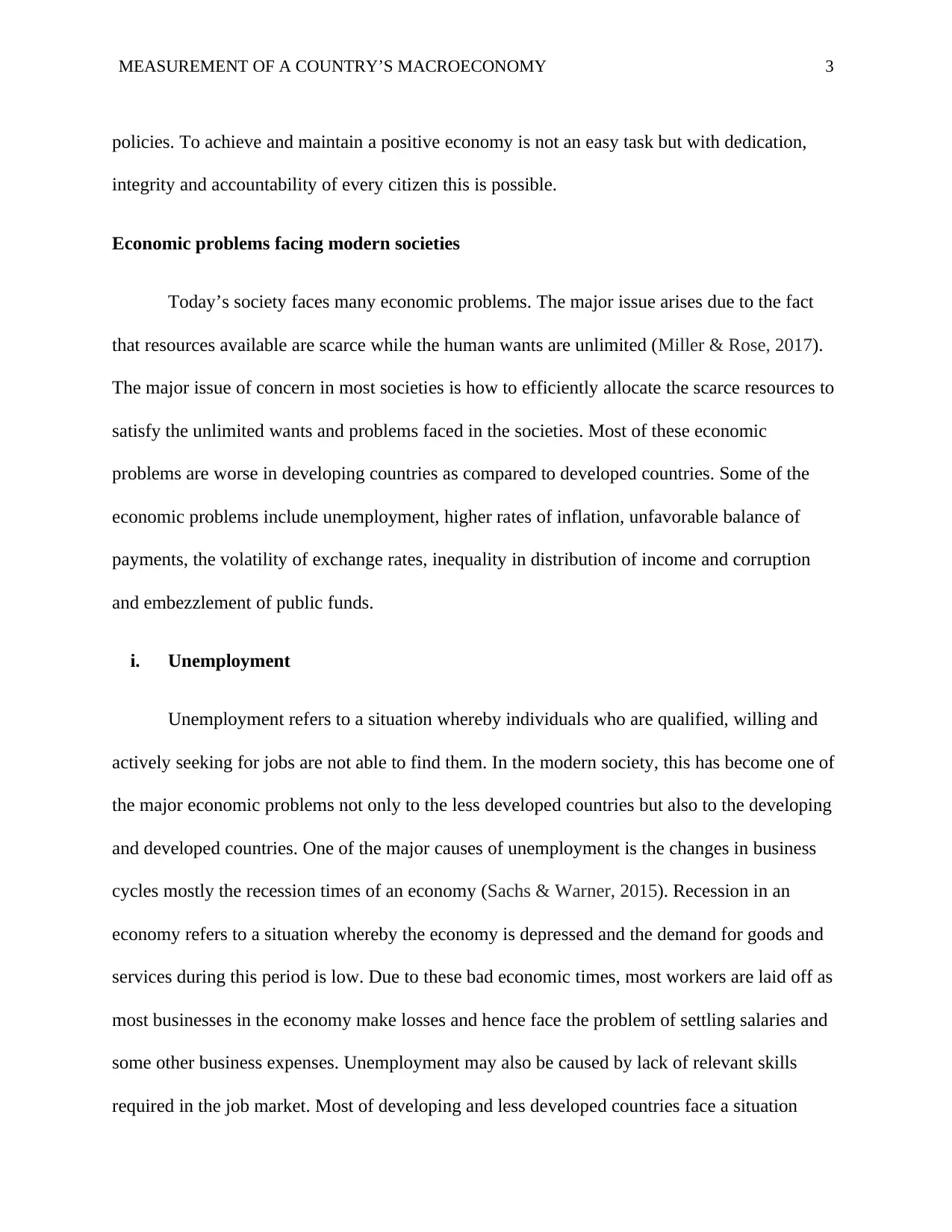
MEASUREMENT OF A COUNTRY’S MACROECONOMY 3
policies. To achieve and maintain a positive economy is not an easy task but with dedication,
integrity and accountability of every citizen this is possible.
Economic problems facing modern societies
Today’s society faces many economic problems. The major issue arises due to the fact
that resources available are scarce while the human wants are unlimited (Miller & Rose, 2017).
The major issue of concern in most societies is how to efficiently allocate the scarce resources to
satisfy the unlimited wants and problems faced in the societies. Most of these economic
problems are worse in developing countries as compared to developed countries. Some of the
economic problems include unemployment, higher rates of inflation, unfavorable balance of
payments, the volatility of exchange rates, inequality in distribution of income and corruption
and embezzlement of public funds.
i. Unemployment
Unemployment refers to a situation whereby individuals who are qualified, willing and
actively seeking for jobs are not able to find them. In the modern society, this has become one of
the major economic problems not only to the less developed countries but also to the developing
and developed countries. One of the major causes of unemployment is the changes in business
cycles mostly the recession times of an economy (Sachs & Warner, 2015). Recession in an
economy refers to a situation whereby the economy is depressed and the demand for goods and
services during this period is low. Due to these bad economic times, most workers are laid off as
most businesses in the economy make losses and hence face the problem of settling salaries and
some other business expenses. Unemployment may also be caused by lack of relevant skills
required in the job market. Most of developing and less developed countries face a situation
policies. To achieve and maintain a positive economy is not an easy task but with dedication,
integrity and accountability of every citizen this is possible.
Economic problems facing modern societies
Today’s society faces many economic problems. The major issue arises due to the fact
that resources available are scarce while the human wants are unlimited (Miller & Rose, 2017).
The major issue of concern in most societies is how to efficiently allocate the scarce resources to
satisfy the unlimited wants and problems faced in the societies. Most of these economic
problems are worse in developing countries as compared to developed countries. Some of the
economic problems include unemployment, higher rates of inflation, unfavorable balance of
payments, the volatility of exchange rates, inequality in distribution of income and corruption
and embezzlement of public funds.
i. Unemployment
Unemployment refers to a situation whereby individuals who are qualified, willing and
actively seeking for jobs are not able to find them. In the modern society, this has become one of
the major economic problems not only to the less developed countries but also to the developing
and developed countries. One of the major causes of unemployment is the changes in business
cycles mostly the recession times of an economy (Sachs & Warner, 2015). Recession in an
economy refers to a situation whereby the economy is depressed and the demand for goods and
services during this period is low. Due to these bad economic times, most workers are laid off as
most businesses in the economy make losses and hence face the problem of settling salaries and
some other business expenses. Unemployment may also be caused by lack of relevant skills
required in the job market. Most of developing and less developed countries face a situation
⊘ This is a preview!⊘
Do you want full access?
Subscribe today to unlock all pages.

Trusted by 1+ million students worldwide
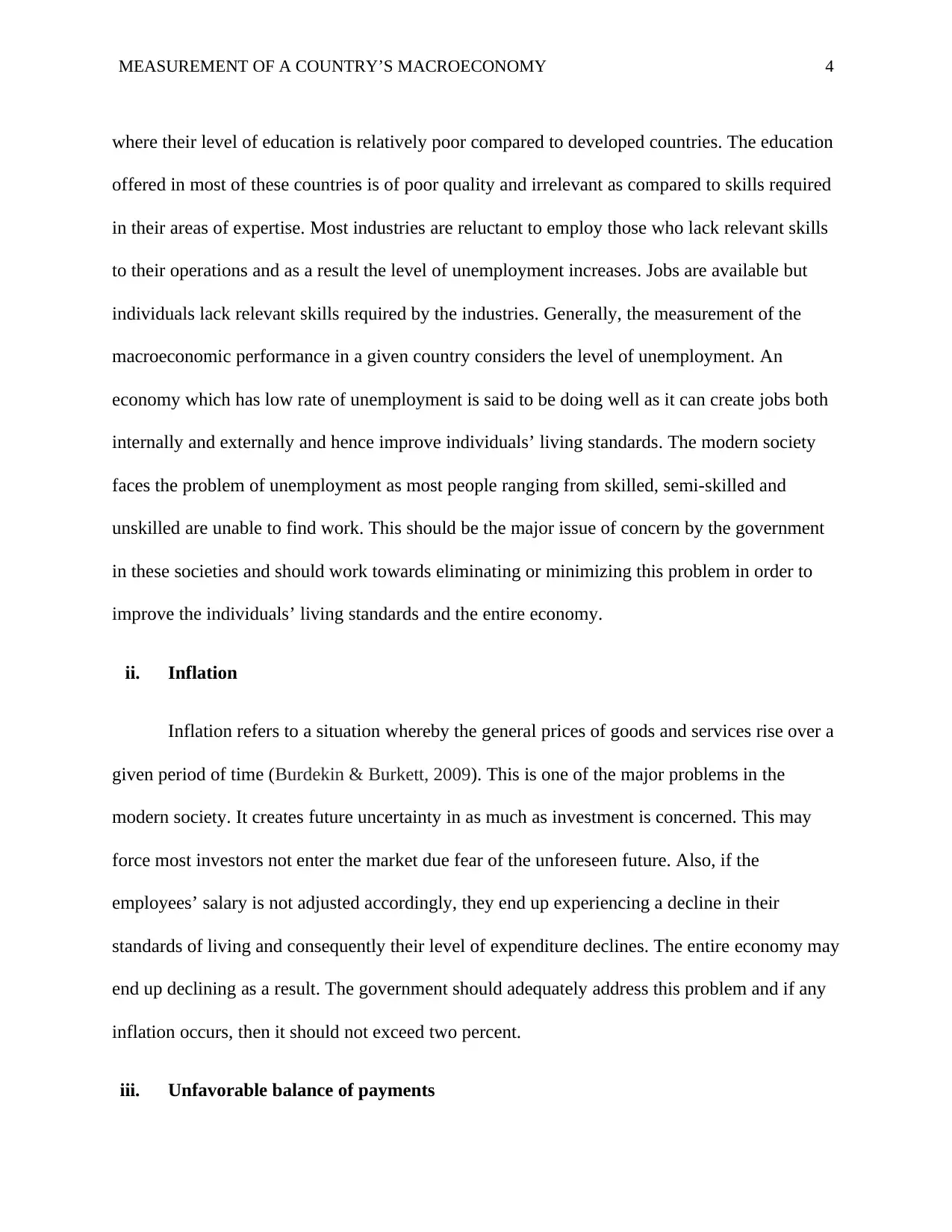
MEASUREMENT OF A COUNTRY’S MACROECONOMY 4
where their level of education is relatively poor compared to developed countries. The education
offered in most of these countries is of poor quality and irrelevant as compared to skills required
in their areas of expertise. Most industries are reluctant to employ those who lack relevant skills
to their operations and as a result the level of unemployment increases. Jobs are available but
individuals lack relevant skills required by the industries. Generally, the measurement of the
macroeconomic performance in a given country considers the level of unemployment. An
economy which has low rate of unemployment is said to be doing well as it can create jobs both
internally and externally and hence improve individuals’ living standards. The modern society
faces the problem of unemployment as most people ranging from skilled, semi-skilled and
unskilled are unable to find work. This should be the major issue of concern by the government
in these societies and should work towards eliminating or minimizing this problem in order to
improve the individuals’ living standards and the entire economy.
ii. Inflation
Inflation refers to a situation whereby the general prices of goods and services rise over a
given period of time (Burdekin & Burkett, 2009). This is one of the major problems in the
modern society. It creates future uncertainty in as much as investment is concerned. This may
force most investors not enter the market due fear of the unforeseen future. Also, if the
employees’ salary is not adjusted accordingly, they end up experiencing a decline in their
standards of living and consequently their level of expenditure declines. The entire economy may
end up declining as a result. The government should adequately address this problem and if any
inflation occurs, then it should not exceed two percent.
iii. Unfavorable balance of payments
where their level of education is relatively poor compared to developed countries. The education
offered in most of these countries is of poor quality and irrelevant as compared to skills required
in their areas of expertise. Most industries are reluctant to employ those who lack relevant skills
to their operations and as a result the level of unemployment increases. Jobs are available but
individuals lack relevant skills required by the industries. Generally, the measurement of the
macroeconomic performance in a given country considers the level of unemployment. An
economy which has low rate of unemployment is said to be doing well as it can create jobs both
internally and externally and hence improve individuals’ living standards. The modern society
faces the problem of unemployment as most people ranging from skilled, semi-skilled and
unskilled are unable to find work. This should be the major issue of concern by the government
in these societies and should work towards eliminating or minimizing this problem in order to
improve the individuals’ living standards and the entire economy.
ii. Inflation
Inflation refers to a situation whereby the general prices of goods and services rise over a
given period of time (Burdekin & Burkett, 2009). This is one of the major problems in the
modern society. It creates future uncertainty in as much as investment is concerned. This may
force most investors not enter the market due fear of the unforeseen future. Also, if the
employees’ salary is not adjusted accordingly, they end up experiencing a decline in their
standards of living and consequently their level of expenditure declines. The entire economy may
end up declining as a result. The government should adequately address this problem and if any
inflation occurs, then it should not exceed two percent.
iii. Unfavorable balance of payments
Paraphrase This Document
Need a fresh take? Get an instant paraphrase of this document with our AI Paraphraser
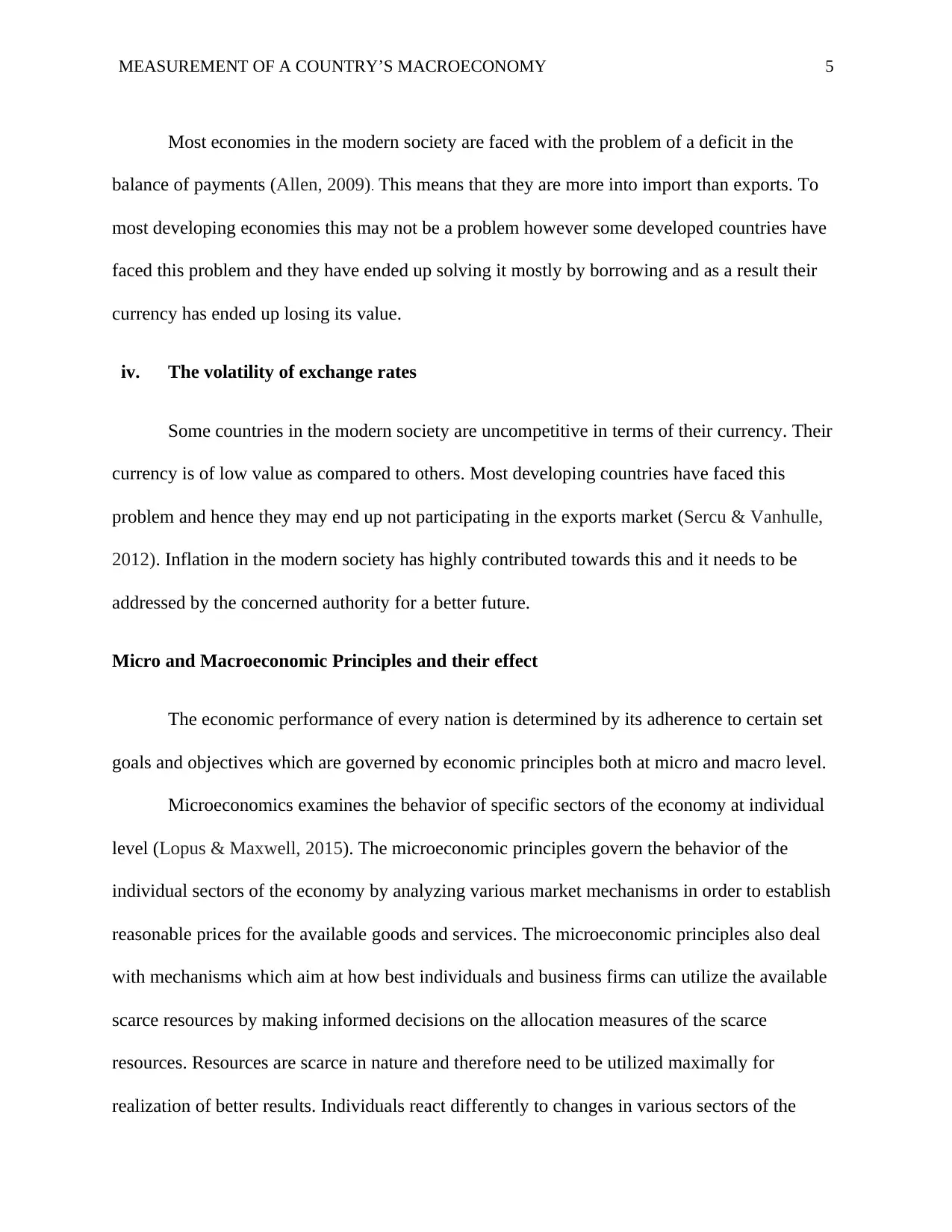
MEASUREMENT OF A COUNTRY’S MACROECONOMY 5
Most economies in the modern society are faced with the problem of a deficit in the
balance of payments (Allen, 2009). This means that they are more into import than exports. To
most developing economies this may not be a problem however some developed countries have
faced this problem and they have ended up solving it mostly by borrowing and as a result their
currency has ended up losing its value.
iv. The volatility of exchange rates
Some countries in the modern society are uncompetitive in terms of their currency. Their
currency is of low value as compared to others. Most developing countries have faced this
problem and hence they may end up not participating in the exports market (Sercu & Vanhulle,
2012). Inflation in the modern society has highly contributed towards this and it needs to be
addressed by the concerned authority for a better future.
Micro and Macroeconomic Principles and their effect
The economic performance of every nation is determined by its adherence to certain set
goals and objectives which are governed by economic principles both at micro and macro level.
Microeconomics examines the behavior of specific sectors of the economy at individual
level (Lopus & Maxwell, 2015). The microeconomic principles govern the behavior of the
individual sectors of the economy by analyzing various market mechanisms in order to establish
reasonable prices for the available goods and services. The microeconomic principles also deal
with mechanisms which aim at how best individuals and business firms can utilize the available
scarce resources by making informed decisions on the allocation measures of the scarce
resources. Resources are scarce in nature and therefore need to be utilized maximally for
realization of better results. Individuals react differently to changes in various sectors of the
Most economies in the modern society are faced with the problem of a deficit in the
balance of payments (Allen, 2009). This means that they are more into import than exports. To
most developing economies this may not be a problem however some developed countries have
faced this problem and they have ended up solving it mostly by borrowing and as a result their
currency has ended up losing its value.
iv. The volatility of exchange rates
Some countries in the modern society are uncompetitive in terms of their currency. Their
currency is of low value as compared to others. Most developing countries have faced this
problem and hence they may end up not participating in the exports market (Sercu & Vanhulle,
2012). Inflation in the modern society has highly contributed towards this and it needs to be
addressed by the concerned authority for a better future.
Micro and Macroeconomic Principles and their effect
The economic performance of every nation is determined by its adherence to certain set
goals and objectives which are governed by economic principles both at micro and macro level.
Microeconomics examines the behavior of specific sectors of the economy at individual
level (Lopus & Maxwell, 2015). The microeconomic principles govern the behavior of the
individual sectors of the economy by analyzing various market mechanisms in order to establish
reasonable prices for the available goods and services. The microeconomic principles also deal
with mechanisms which aim at how best individuals and business firms can utilize the available
scarce resources by making informed decisions on the allocation measures of the scarce
resources. Resources are scarce in nature and therefore need to be utilized maximally for
realization of better results. Individuals react differently to changes in various sectors of the
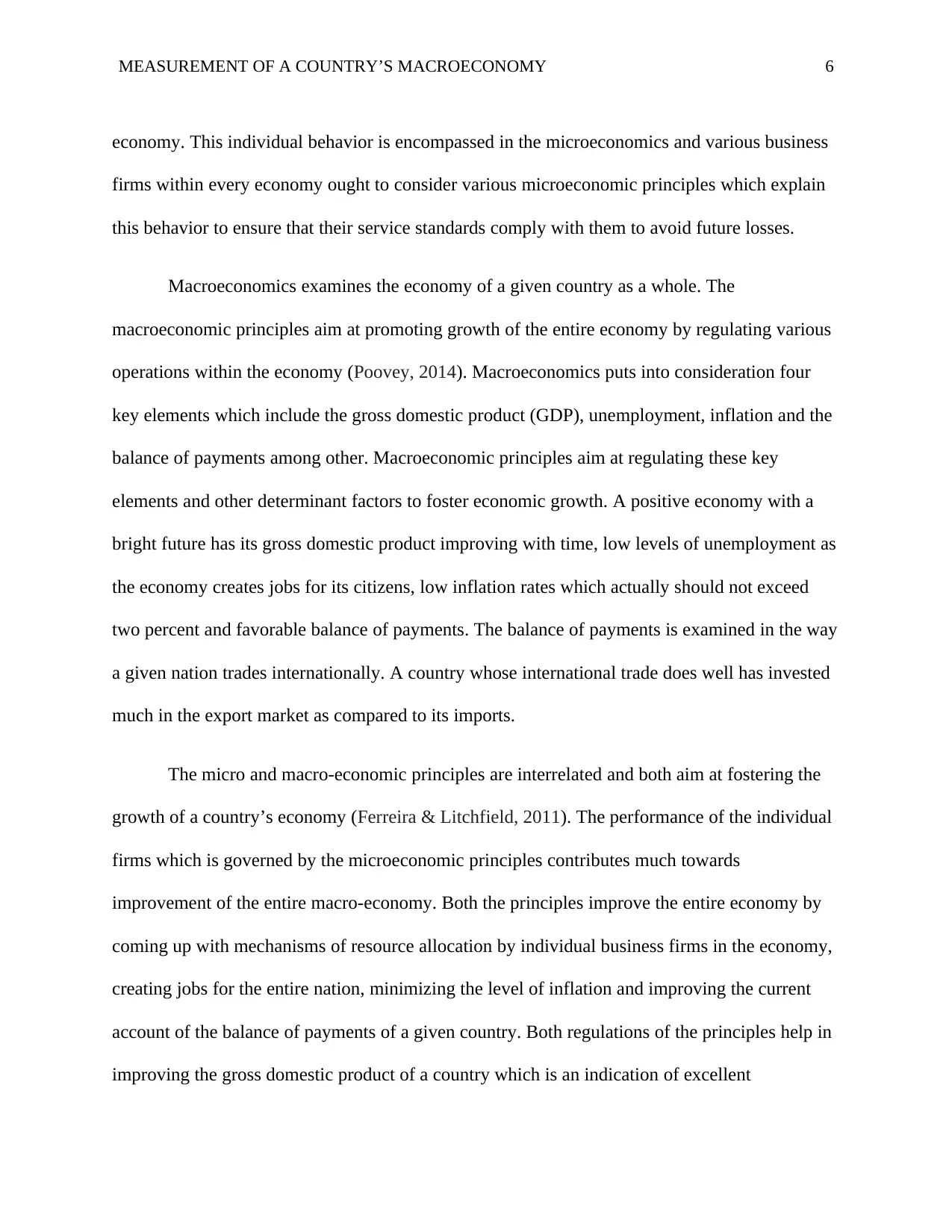
MEASUREMENT OF A COUNTRY’S MACROECONOMY 6
economy. This individual behavior is encompassed in the microeconomics and various business
firms within every economy ought to consider various microeconomic principles which explain
this behavior to ensure that their service standards comply with them to avoid future losses.
Macroeconomics examines the economy of a given country as a whole. The
macroeconomic principles aim at promoting growth of the entire economy by regulating various
operations within the economy (Poovey, 2014). Macroeconomics puts into consideration four
key elements which include the gross domestic product (GDP), unemployment, inflation and the
balance of payments among other. Macroeconomic principles aim at regulating these key
elements and other determinant factors to foster economic growth. A positive economy with a
bright future has its gross domestic product improving with time, low levels of unemployment as
the economy creates jobs for its citizens, low inflation rates which actually should not exceed
two percent and favorable balance of payments. The balance of payments is examined in the way
a given nation trades internationally. A country whose international trade does well has invested
much in the export market as compared to its imports.
The micro and macro-economic principles are interrelated and both aim at fostering the
growth of a country’s economy (Ferreira & Litchfield, 2011). The performance of the individual
firms which is governed by the microeconomic principles contributes much towards
improvement of the entire macro-economy. Both the principles improve the entire economy by
coming up with mechanisms of resource allocation by individual business firms in the economy,
creating jobs for the entire nation, minimizing the level of inflation and improving the current
account of the balance of payments of a given country. Both regulations of the principles help in
improving the gross domestic product of a country which is an indication of excellent
economy. This individual behavior is encompassed in the microeconomics and various business
firms within every economy ought to consider various microeconomic principles which explain
this behavior to ensure that their service standards comply with them to avoid future losses.
Macroeconomics examines the economy of a given country as a whole. The
macroeconomic principles aim at promoting growth of the entire economy by regulating various
operations within the economy (Poovey, 2014). Macroeconomics puts into consideration four
key elements which include the gross domestic product (GDP), unemployment, inflation and the
balance of payments among other. Macroeconomic principles aim at regulating these key
elements and other determinant factors to foster economic growth. A positive economy with a
bright future has its gross domestic product improving with time, low levels of unemployment as
the economy creates jobs for its citizens, low inflation rates which actually should not exceed
two percent and favorable balance of payments. The balance of payments is examined in the way
a given nation trades internationally. A country whose international trade does well has invested
much in the export market as compared to its imports.
The micro and macro-economic principles are interrelated and both aim at fostering the
growth of a country’s economy (Ferreira & Litchfield, 2011). The performance of the individual
firms which is governed by the microeconomic principles contributes much towards
improvement of the entire macro-economy. Both the principles improve the entire economy by
coming up with mechanisms of resource allocation by individual business firms in the economy,
creating jobs for the entire nation, minimizing the level of inflation and improving the current
account of the balance of payments of a given country. Both regulations of the principles help in
improving the gross domestic product of a country which is an indication of excellent
⊘ This is a preview!⊘
Do you want full access?
Subscribe today to unlock all pages.

Trusted by 1+ million students worldwide
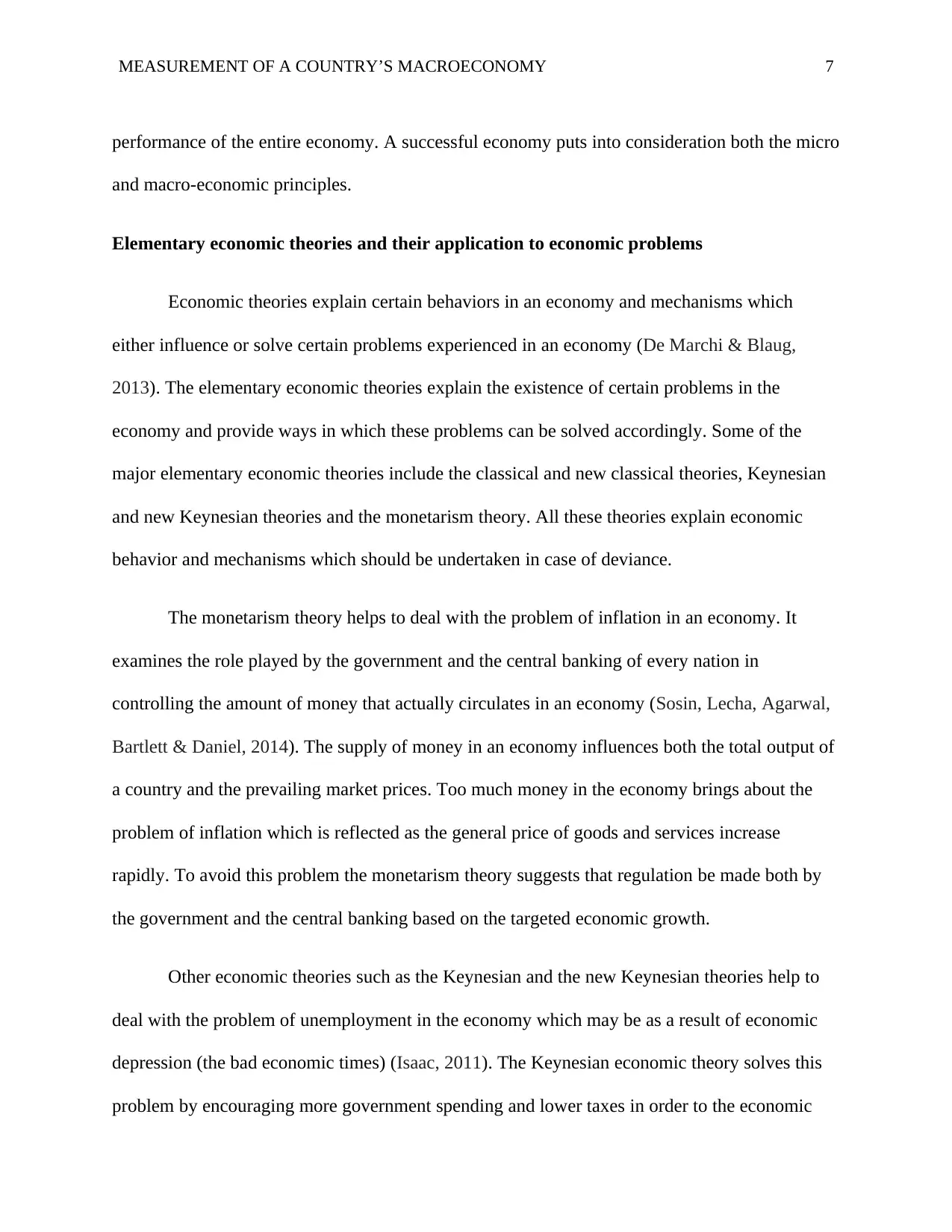
MEASUREMENT OF A COUNTRY’S MACROECONOMY 7
performance of the entire economy. A successful economy puts into consideration both the micro
and macro-economic principles.
Elementary economic theories and their application to economic problems
Economic theories explain certain behaviors in an economy and mechanisms which
either influence or solve certain problems experienced in an economy (De Marchi & Blaug,
2013). The elementary economic theories explain the existence of certain problems in the
economy and provide ways in which these problems can be solved accordingly. Some of the
major elementary economic theories include the classical and new classical theories, Keynesian
and new Keynesian theories and the monetarism theory. All these theories explain economic
behavior and mechanisms which should be undertaken in case of deviance.
The monetarism theory helps to deal with the problem of inflation in an economy. It
examines the role played by the government and the central banking of every nation in
controlling the amount of money that actually circulates in an economy (Sosin, Lecha, Agarwal,
Bartlett & Daniel, 2014). The supply of money in an economy influences both the total output of
a country and the prevailing market prices. Too much money in the economy brings about the
problem of inflation which is reflected as the general price of goods and services increase
rapidly. To avoid this problem the monetarism theory suggests that regulation be made both by
the government and the central banking based on the targeted economic growth.
Other economic theories such as the Keynesian and the new Keynesian theories help to
deal with the problem of unemployment in the economy which may be as a result of economic
depression (the bad economic times) (Isaac, 2011). The Keynesian economic theory solves this
problem by encouraging more government spending and lower taxes in order to the economic
performance of the entire economy. A successful economy puts into consideration both the micro
and macro-economic principles.
Elementary economic theories and their application to economic problems
Economic theories explain certain behaviors in an economy and mechanisms which
either influence or solve certain problems experienced in an economy (De Marchi & Blaug,
2013). The elementary economic theories explain the existence of certain problems in the
economy and provide ways in which these problems can be solved accordingly. Some of the
major elementary economic theories include the classical and new classical theories, Keynesian
and new Keynesian theories and the monetarism theory. All these theories explain economic
behavior and mechanisms which should be undertaken in case of deviance.
The monetarism theory helps to deal with the problem of inflation in an economy. It
examines the role played by the government and the central banking of every nation in
controlling the amount of money that actually circulates in an economy (Sosin, Lecha, Agarwal,
Bartlett & Daniel, 2014). The supply of money in an economy influences both the total output of
a country and the prevailing market prices. Too much money in the economy brings about the
problem of inflation which is reflected as the general price of goods and services increase
rapidly. To avoid this problem the monetarism theory suggests that regulation be made both by
the government and the central banking based on the targeted economic growth.
Other economic theories such as the Keynesian and the new Keynesian theories help to
deal with the problem of unemployment in the economy which may be as a result of economic
depression (the bad economic times) (Isaac, 2011). The Keynesian economic theory solves this
problem by encouraging more government spending and lower taxes in order to the economic
Paraphrase This Document
Need a fresh take? Get an instant paraphrase of this document with our AI Paraphraser
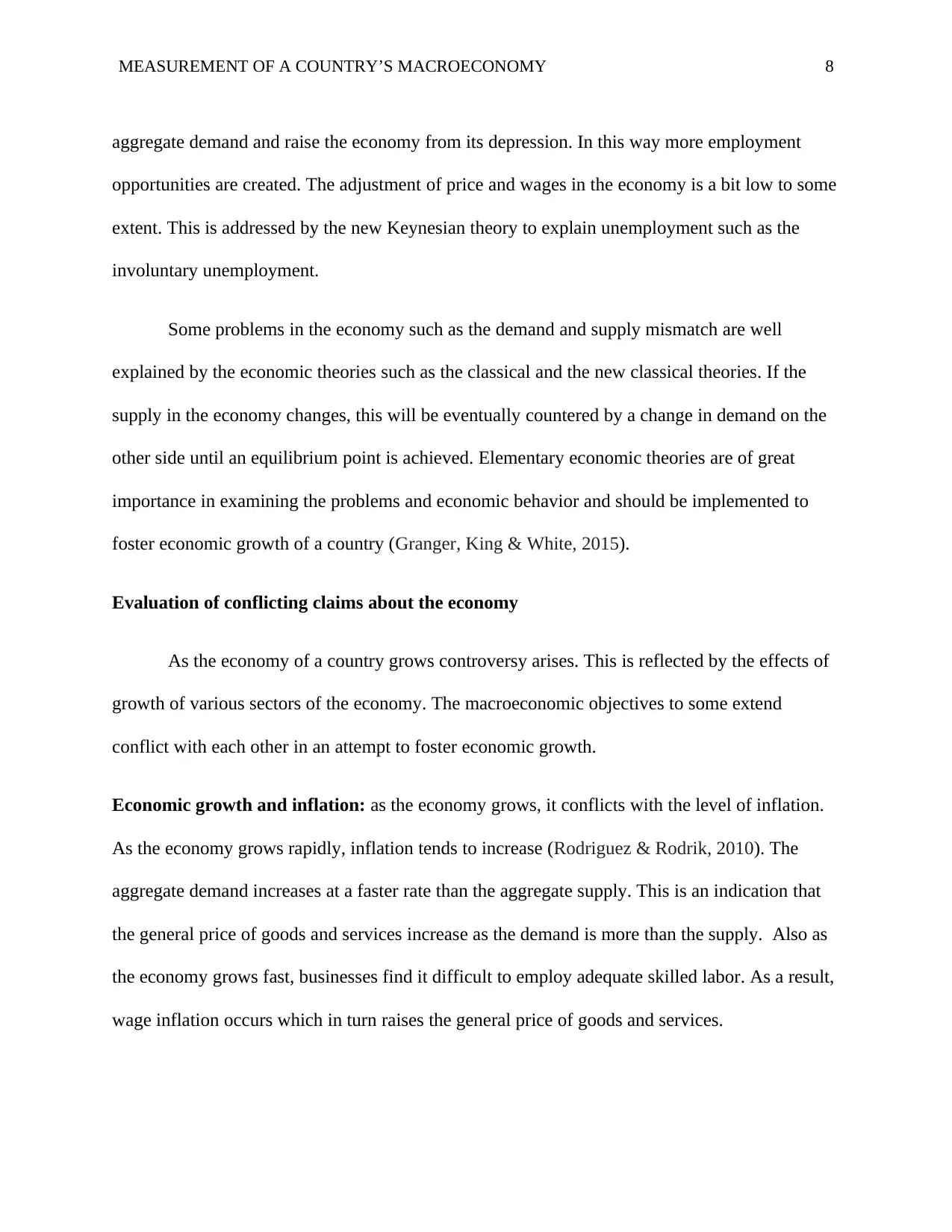
MEASUREMENT OF A COUNTRY’S MACROECONOMY 8
aggregate demand and raise the economy from its depression. In this way more employment
opportunities are created. The adjustment of price and wages in the economy is a bit low to some
extent. This is addressed by the new Keynesian theory to explain unemployment such as the
involuntary unemployment.
Some problems in the economy such as the demand and supply mismatch are well
explained by the economic theories such as the classical and the new classical theories. If the
supply in the economy changes, this will be eventually countered by a change in demand on the
other side until an equilibrium point is achieved. Elementary economic theories are of great
importance in examining the problems and economic behavior and should be implemented to
foster economic growth of a country (Granger, King & White, 2015).
Evaluation of conflicting claims about the economy
As the economy of a country grows controversy arises. This is reflected by the effects of
growth of various sectors of the economy. The macroeconomic objectives to some extend
conflict with each other in an attempt to foster economic growth.
Economic growth and inflation: as the economy grows, it conflicts with the level of inflation.
As the economy grows rapidly, inflation tends to increase (Rodriguez & Rodrik, 2010). The
aggregate demand increases at a faster rate than the aggregate supply. This is an indication that
the general price of goods and services increase as the demand is more than the supply. Also as
the economy grows fast, businesses find it difficult to employ adequate skilled labor. As a result,
wage inflation occurs which in turn raises the general price of goods and services.
aggregate demand and raise the economy from its depression. In this way more employment
opportunities are created. The adjustment of price and wages in the economy is a bit low to some
extent. This is addressed by the new Keynesian theory to explain unemployment such as the
involuntary unemployment.
Some problems in the economy such as the demand and supply mismatch are well
explained by the economic theories such as the classical and the new classical theories. If the
supply in the economy changes, this will be eventually countered by a change in demand on the
other side until an equilibrium point is achieved. Elementary economic theories are of great
importance in examining the problems and economic behavior and should be implemented to
foster economic growth of a country (Granger, King & White, 2015).
Evaluation of conflicting claims about the economy
As the economy of a country grows controversy arises. This is reflected by the effects of
growth of various sectors of the economy. The macroeconomic objectives to some extend
conflict with each other in an attempt to foster economic growth.
Economic growth and inflation: as the economy grows, it conflicts with the level of inflation.
As the economy grows rapidly, inflation tends to increase (Rodriguez & Rodrik, 2010). The
aggregate demand increases at a faster rate than the aggregate supply. This is an indication that
the general price of goods and services increase as the demand is more than the supply. Also as
the economy grows fast, businesses find it difficult to employ adequate skilled labor. As a result,
wage inflation occurs which in turn raises the general price of goods and services.
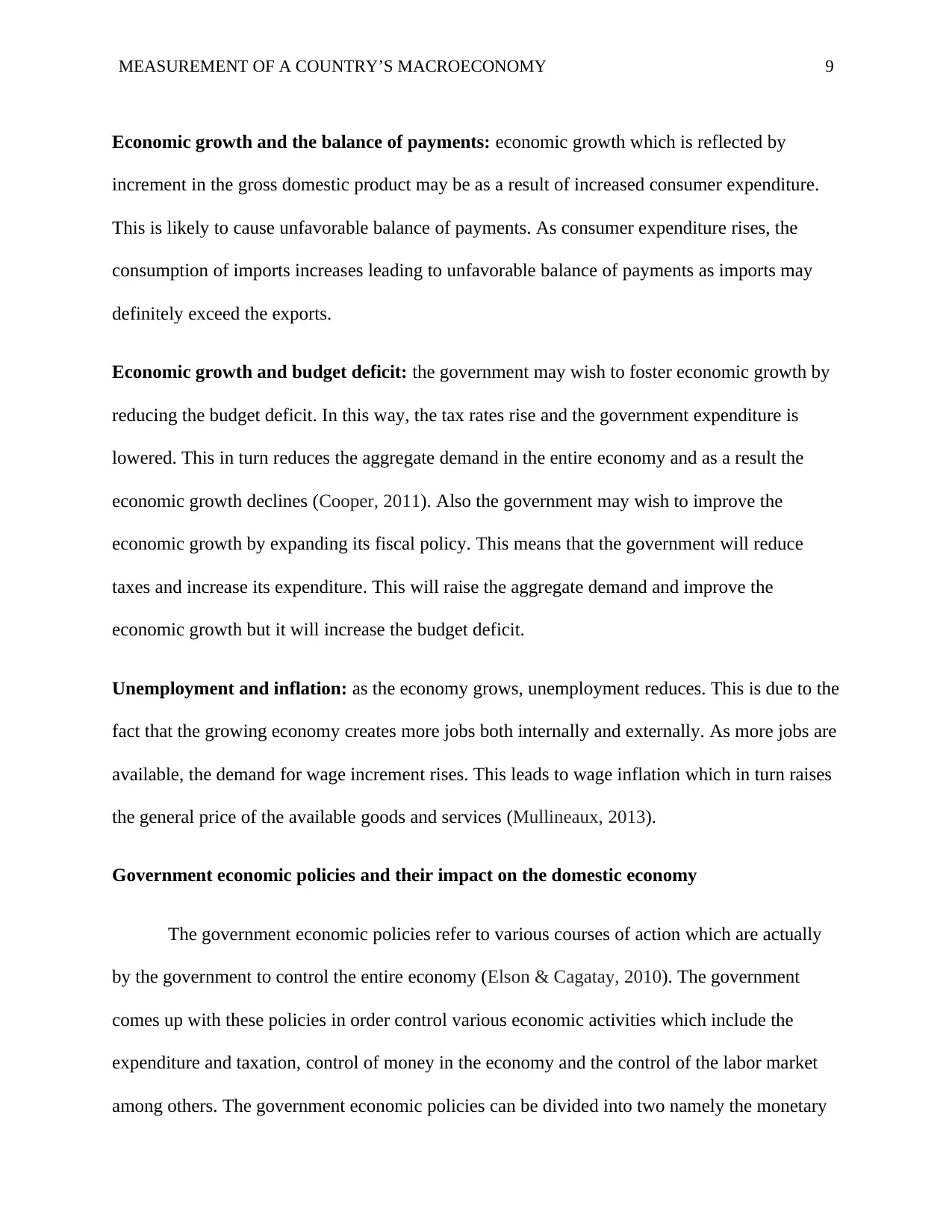
MEASUREMENT OF A COUNTRY’S MACROECONOMY 9
Economic growth and the balance of payments: economic growth which is reflected by
increment in the gross domestic product may be as a result of increased consumer expenditure.
This is likely to cause unfavorable balance of payments. As consumer expenditure rises, the
consumption of imports increases leading to unfavorable balance of payments as imports may
definitely exceed the exports.
Economic growth and budget deficit: the government may wish to foster economic growth by
reducing the budget deficit. In this way, the tax rates rise and the government expenditure is
lowered. This in turn reduces the aggregate demand in the entire economy and as a result the
economic growth declines (Cooper, 2011). Also the government may wish to improve the
economic growth by expanding its fiscal policy. This means that the government will reduce
taxes and increase its expenditure. This will raise the aggregate demand and improve the
economic growth but it will increase the budget deficit.
Unemployment and inflation: as the economy grows, unemployment reduces. This is due to the
fact that the growing economy creates more jobs both internally and externally. As more jobs are
available, the demand for wage increment rises. This leads to wage inflation which in turn raises
the general price of the available goods and services (Mullineaux, 2013).
Government economic policies and their impact on the domestic economy
The government economic policies refer to various courses of action which are actually
by the government to control the entire economy (Elson & Cagatay, 2010). The government
comes up with these policies in order control various economic activities which include the
expenditure and taxation, control of money in the economy and the control of the labor market
among others. The government economic policies can be divided into two namely the monetary
Economic growth and the balance of payments: economic growth which is reflected by
increment in the gross domestic product may be as a result of increased consumer expenditure.
This is likely to cause unfavorable balance of payments. As consumer expenditure rises, the
consumption of imports increases leading to unfavorable balance of payments as imports may
definitely exceed the exports.
Economic growth and budget deficit: the government may wish to foster economic growth by
reducing the budget deficit. In this way, the tax rates rise and the government expenditure is
lowered. This in turn reduces the aggregate demand in the entire economy and as a result the
economic growth declines (Cooper, 2011). Also the government may wish to improve the
economic growth by expanding its fiscal policy. This means that the government will reduce
taxes and increase its expenditure. This will raise the aggregate demand and improve the
economic growth but it will increase the budget deficit.
Unemployment and inflation: as the economy grows, unemployment reduces. This is due to the
fact that the growing economy creates more jobs both internally and externally. As more jobs are
available, the demand for wage increment rises. This leads to wage inflation which in turn raises
the general price of the available goods and services (Mullineaux, 2013).
Government economic policies and their impact on the domestic economy
The government economic policies refer to various courses of action which are actually
by the government to control the entire economy (Elson & Cagatay, 2010). The government
comes up with these policies in order control various economic activities which include the
expenditure and taxation, control of money in the economy and the control of the labor market
among others. The government economic policies can be divided into two namely the monetary
⊘ This is a preview!⊘
Do you want full access?
Subscribe today to unlock all pages.

Trusted by 1+ million students worldwide
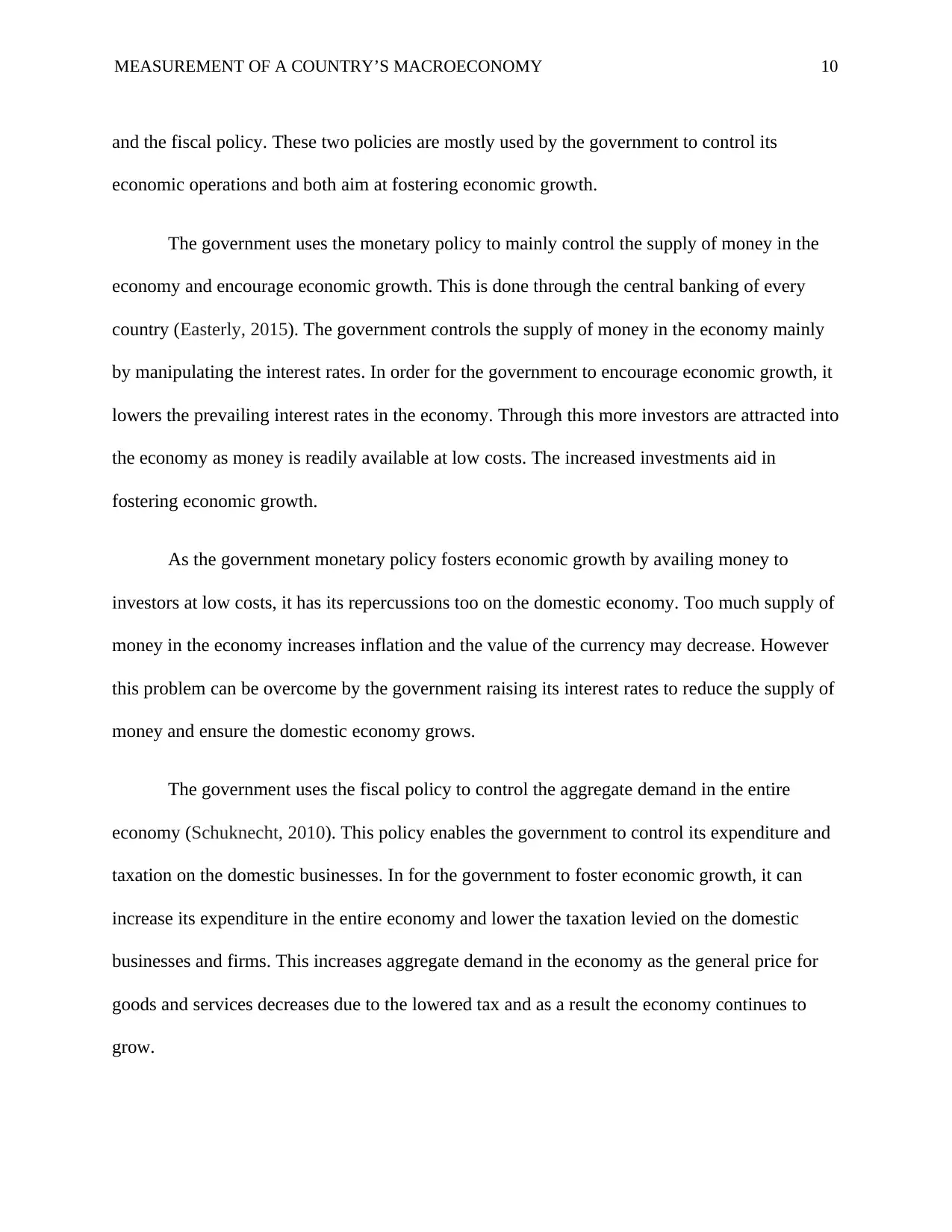
MEASUREMENT OF A COUNTRY’S MACROECONOMY 10
and the fiscal policy. These two policies are mostly used by the government to control its
economic operations and both aim at fostering economic growth.
The government uses the monetary policy to mainly control the supply of money in the
economy and encourage economic growth. This is done through the central banking of every
country (Easterly, 2015). The government controls the supply of money in the economy mainly
by manipulating the interest rates. In order for the government to encourage economic growth, it
lowers the prevailing interest rates in the economy. Through this more investors are attracted into
the economy as money is readily available at low costs. The increased investments aid in
fostering economic growth.
As the government monetary policy fosters economic growth by availing money to
investors at low costs, it has its repercussions too on the domestic economy. Too much supply of
money in the economy increases inflation and the value of the currency may decrease. However
this problem can be overcome by the government raising its interest rates to reduce the supply of
money and ensure the domestic economy grows.
The government uses the fiscal policy to control the aggregate demand in the entire
economy (Schuknecht, 2010). This policy enables the government to control its expenditure and
taxation on the domestic businesses. In for the government to foster economic growth, it can
increase its expenditure in the entire economy and lower the taxation levied on the domestic
businesses and firms. This increases aggregate demand in the economy as the general price for
goods and services decreases due to the lowered tax and as a result the economy continues to
grow.
and the fiscal policy. These two policies are mostly used by the government to control its
economic operations and both aim at fostering economic growth.
The government uses the monetary policy to mainly control the supply of money in the
economy and encourage economic growth. This is done through the central banking of every
country (Easterly, 2015). The government controls the supply of money in the economy mainly
by manipulating the interest rates. In order for the government to encourage economic growth, it
lowers the prevailing interest rates in the economy. Through this more investors are attracted into
the economy as money is readily available at low costs. The increased investments aid in
fostering economic growth.
As the government monetary policy fosters economic growth by availing money to
investors at low costs, it has its repercussions too on the domestic economy. Too much supply of
money in the economy increases inflation and the value of the currency may decrease. However
this problem can be overcome by the government raising its interest rates to reduce the supply of
money and ensure the domestic economy grows.
The government uses the fiscal policy to control the aggregate demand in the entire
economy (Schuknecht, 2010). This policy enables the government to control its expenditure and
taxation on the domestic businesses. In for the government to foster economic growth, it can
increase its expenditure in the entire economy and lower the taxation levied on the domestic
businesses and firms. This increases aggregate demand in the economy as the general price for
goods and services decreases due to the lowered tax and as a result the economy continues to
grow.
Paraphrase This Document
Need a fresh take? Get an instant paraphrase of this document with our AI Paraphraser
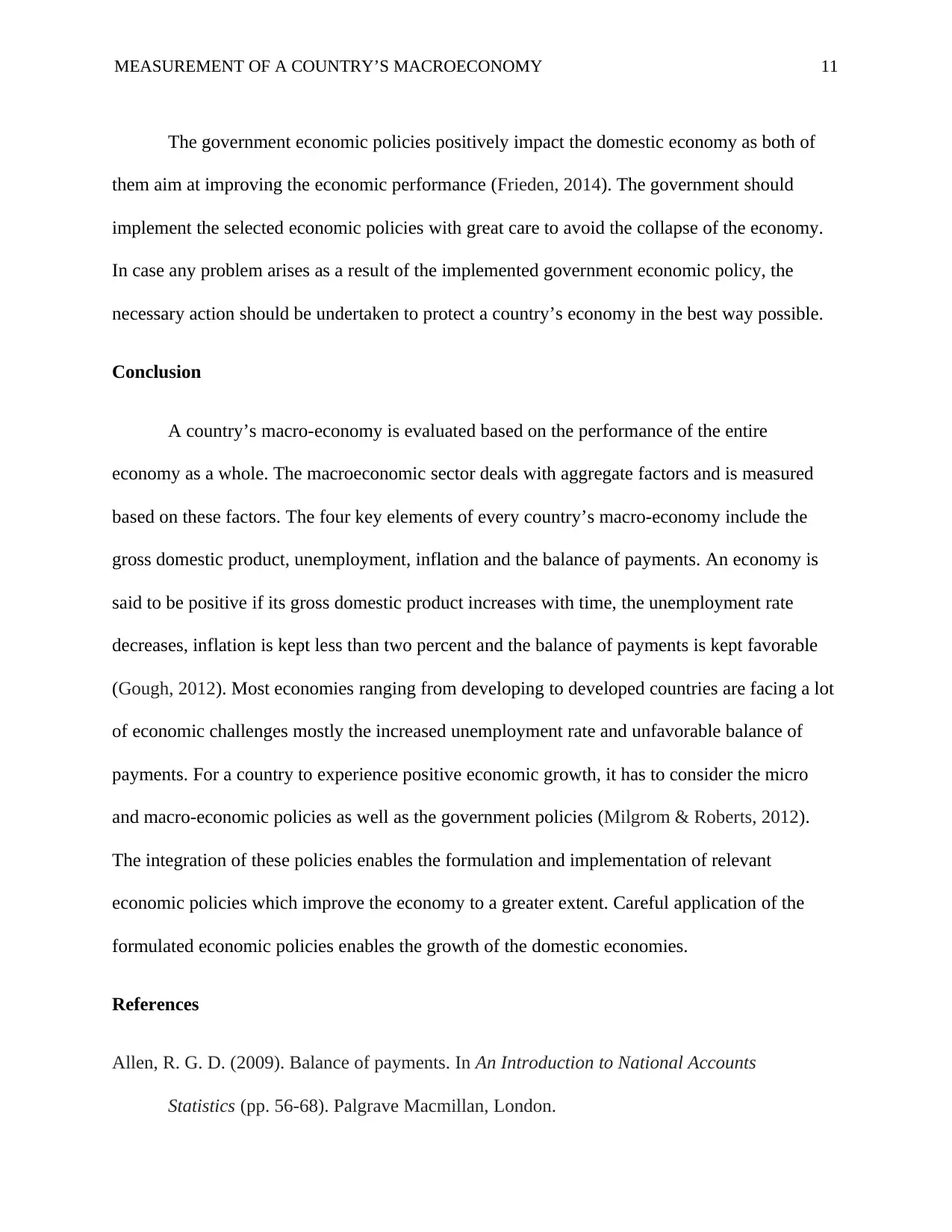
MEASUREMENT OF A COUNTRY’S MACROECONOMY 11
The government economic policies positively impact the domestic economy as both of
them aim at improving the economic performance (Frieden, 2014). The government should
implement the selected economic policies with great care to avoid the collapse of the economy.
In case any problem arises as a result of the implemented government economic policy, the
necessary action should be undertaken to protect a country’s economy in the best way possible.
Conclusion
A country’s macro-economy is evaluated based on the performance of the entire
economy as a whole. The macroeconomic sector deals with aggregate factors and is measured
based on these factors. The four key elements of every country’s macro-economy include the
gross domestic product, unemployment, inflation and the balance of payments. An economy is
said to be positive if its gross domestic product increases with time, the unemployment rate
decreases, inflation is kept less than two percent and the balance of payments is kept favorable
(Gough, 2012). Most economies ranging from developing to developed countries are facing a lot
of economic challenges mostly the increased unemployment rate and unfavorable balance of
payments. For a country to experience positive economic growth, it has to consider the micro
and macro-economic policies as well as the government policies (Milgrom & Roberts, 2012).
The integration of these policies enables the formulation and implementation of relevant
economic policies which improve the economy to a greater extent. Careful application of the
formulated economic policies enables the growth of the domestic economies.
References
Allen, R. G. D. (2009). Balance of payments. In An Introduction to National Accounts
Statistics (pp. 56-68). Palgrave Macmillan, London.
The government economic policies positively impact the domestic economy as both of
them aim at improving the economic performance (Frieden, 2014). The government should
implement the selected economic policies with great care to avoid the collapse of the economy.
In case any problem arises as a result of the implemented government economic policy, the
necessary action should be undertaken to protect a country’s economy in the best way possible.
Conclusion
A country’s macro-economy is evaluated based on the performance of the entire
economy as a whole. The macroeconomic sector deals with aggregate factors and is measured
based on these factors. The four key elements of every country’s macro-economy include the
gross domestic product, unemployment, inflation and the balance of payments. An economy is
said to be positive if its gross domestic product increases with time, the unemployment rate
decreases, inflation is kept less than two percent and the balance of payments is kept favorable
(Gough, 2012). Most economies ranging from developing to developed countries are facing a lot
of economic challenges mostly the increased unemployment rate and unfavorable balance of
payments. For a country to experience positive economic growth, it has to consider the micro
and macro-economic policies as well as the government policies (Milgrom & Roberts, 2012).
The integration of these policies enables the formulation and implementation of relevant
economic policies which improve the economy to a greater extent. Careful application of the
formulated economic policies enables the growth of the domestic economies.
References
Allen, R. G. D. (2009). Balance of payments. In An Introduction to National Accounts
Statistics (pp. 56-68). Palgrave Macmillan, London.
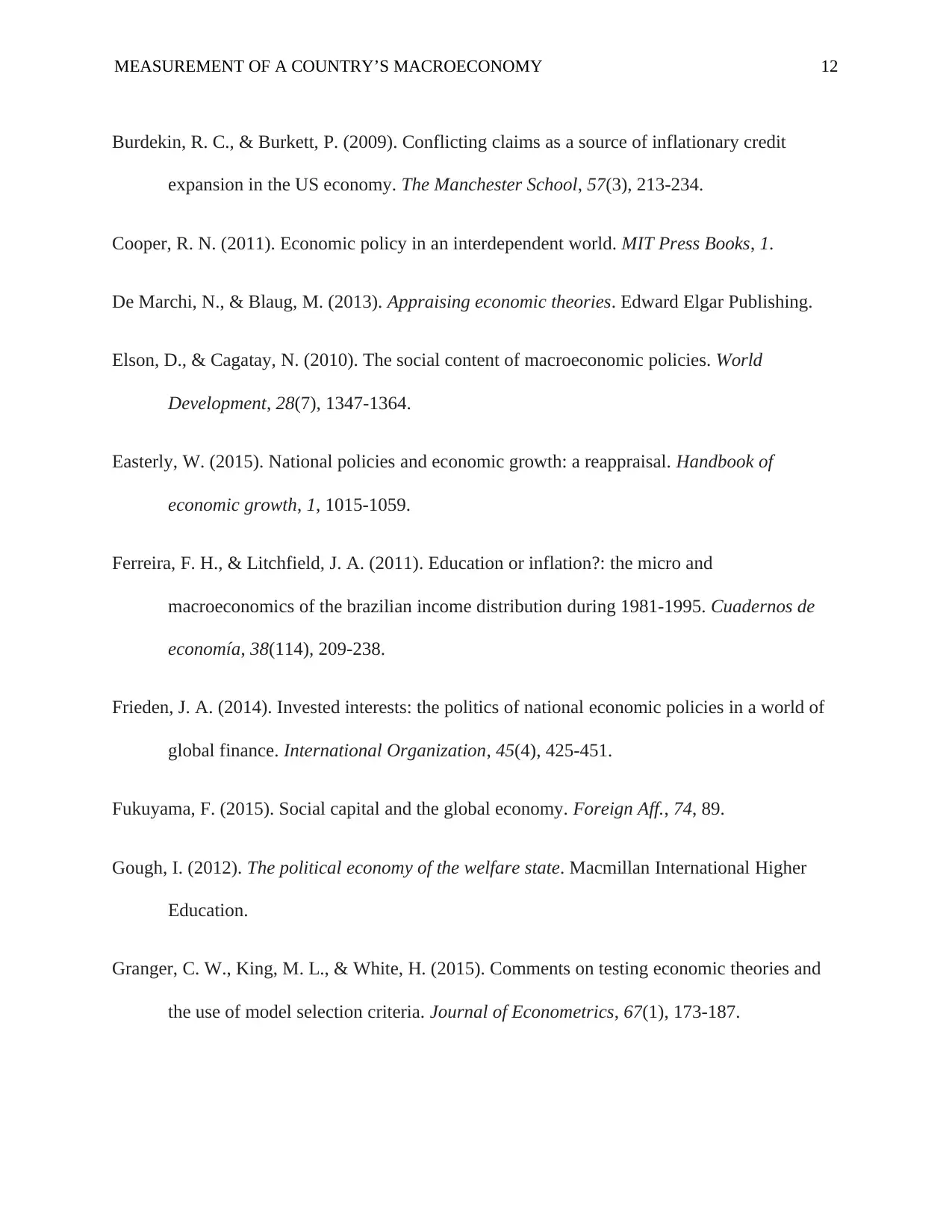
MEASUREMENT OF A COUNTRY’S MACROECONOMY 12
Burdekin, R. C., & Burkett, P. (2009). Conflicting claims as a source of inflationary credit
expansion in the US economy. The Manchester School, 57(3), 213-234.
Cooper, R. N. (2011). Economic policy in an interdependent world. MIT Press Books, 1.
De Marchi, N., & Blaug, M. (2013). Appraising economic theories. Edward Elgar Publishing.
Elson, D., & Cagatay, N. (2010). The social content of macroeconomic policies. World
Development, 28(7), 1347-1364.
Easterly, W. (2015). National policies and economic growth: a reappraisal. Handbook of
economic growth, 1, 1015-1059.
Ferreira, F. H., & Litchfield, J. A. (2011). Education or inflation?: the micro and
macroeconomics of the brazilian income distribution during 1981-1995. Cuadernos de
economía, 38(114), 209-238.
Frieden, J. A. (2014). Invested interests: the politics of national economic policies in a world of
global finance. International Organization, 45(4), 425-451.
Fukuyama, F. (2015). Social capital and the global economy. Foreign Aff., 74, 89.
Gough, I. (2012). The political economy of the welfare state. Macmillan International Higher
Education.
Granger, C. W., King, M. L., & White, H. (2015). Comments on testing economic theories and
the use of model selection criteria. Journal of Econometrics, 67(1), 173-187.
Burdekin, R. C., & Burkett, P. (2009). Conflicting claims as a source of inflationary credit
expansion in the US economy. The Manchester School, 57(3), 213-234.
Cooper, R. N. (2011). Economic policy in an interdependent world. MIT Press Books, 1.
De Marchi, N., & Blaug, M. (2013). Appraising economic theories. Edward Elgar Publishing.
Elson, D., & Cagatay, N. (2010). The social content of macroeconomic policies. World
Development, 28(7), 1347-1364.
Easterly, W. (2015). National policies and economic growth: a reappraisal. Handbook of
economic growth, 1, 1015-1059.
Ferreira, F. H., & Litchfield, J. A. (2011). Education or inflation?: the micro and
macroeconomics of the brazilian income distribution during 1981-1995. Cuadernos de
economía, 38(114), 209-238.
Frieden, J. A. (2014). Invested interests: the politics of national economic policies in a world of
global finance. International Organization, 45(4), 425-451.
Fukuyama, F. (2015). Social capital and the global economy. Foreign Aff., 74, 89.
Gough, I. (2012). The political economy of the welfare state. Macmillan International Higher
Education.
Granger, C. W., King, M. L., & White, H. (2015). Comments on testing economic theories and
the use of model selection criteria. Journal of Econometrics, 67(1), 173-187.
⊘ This is a preview!⊘
Do you want full access?
Subscribe today to unlock all pages.

Trusted by 1+ million students worldwide
1 out of 14
Related Documents
Your All-in-One AI-Powered Toolkit for Academic Success.
+13062052269
info@desklib.com
Available 24*7 on WhatsApp / Email
![[object Object]](/_next/static/media/star-bottom.7253800d.svg)
Unlock your academic potential
Copyright © 2020–2025 A2Z Services. All Rights Reserved. Developed and managed by ZUCOL.





